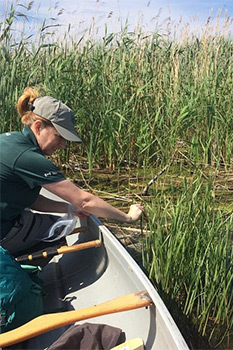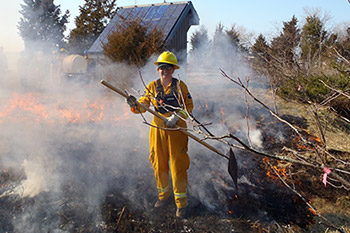Meet Tammy Dobbie
Point Pelee National Park

Job Title
Nature Legacy Park Ecologist
What was your education/career path?
I started as a student in 1989 and I have been working at Point Pelee National Park since 1993. I began my career as a Visitor Centre Attendant at Georgian Bay Islands National Park then worked there as an interpreter during summers while in university.
I took Ecology at the University of Guelph and got a minor in Botany. I had no idea what kind of career I could get by doing that degree, but just knew that I loved the courses about nature and animals and plants, and that I wanted to do something environmental. I ended up thinking I could be a science teacher and went to Teacher’s College at Lakehead University for a year in 1993, but when I graduated, it was a terrible time to try and get a teaching job, one of the worst in history. My summer job at Georgian Bay Islands National Park was ending, and since their Visitor Centre always closed in the winter, there was no hope to get a full time job there…. So I had to start looking elsewhere…
What drew you to Point Pelee? When did you first start working at Point Pelee National Park?
Just as I was leaving my summer job at Georgian Bay Islands National Park and getting ready to apply to be a substitute teacher, a job came up as a Visitor Centre Attendent/Interpreter at Point Pelee National Park. The position started in the fall when most other National Parks were laying off staff for the winter. At the time, Point Pelee was the only visitor centre of a national park in Ontario that was open in the winter. I worked in Interpretation and Visitor Experience on term contracts for many years, then applied to the Warden Service and became a Park Warden in 1998. In 2005 I became the Park Ecologist.
What do you do for Parks Canada?

My official job title is “Ecosystem Scientist II”, and my main job duty is to lead projects and provide advice to Parks Canada managers and partners about issues that involve ecological integrity, environmental issues, ecosystem management and Species at Risk. Sometimes I have to evaluate and analyze technical scientific information and data to support ecological decision-making and I help with park strategic planning and contribute to efforts to conduct landscape-scale ecological conservation and restoration outside the park boundaries as well. Recently, I’ve been working on Nature Legacy initiatives such as revising the parks’ Multi-Species Action Plan to help recover Species at Risk (SAR), working with regional partners to plan for improved Landscape Connectivity in the watersheds surrounding the park, beginning to plan for Climate Change adaptations for the park and region and working with regional partners to find solutions for coastal erosion.
Sometimes I do get out of the office and I set up and conduct monitoring and research projects to help animals in the park, such as Eastern Foxsnakes, Five-lined Skinks, Southern Flying Squirrel and plants such as Wild Hyacinth, Kentucky Coffee-tree and Eastern Prickly Pear Cactus. I participate in restoration activities such as conducting prescribed fires to improve savannah habitat and removing invasive alien plant species that can harm native species.
What would you tell a young girl about working in science, technology, engineering and mathematics (STEM)?
Don’t underestimate your ability to do anything you feel passionate about. If you spend time and effort, you can find a job that involves subjects you really care about, and that makes coming to work enjoyable. There will always be not-fun, gross, hard, boring and frustrating parts of any job (mine included!), but if you care about what you do and you are willing to do the less-than-glamourous things, you will be rewarded with the fun parts and you will feel the satisfaction and pride of doing work that matters and that makes the world a better place.
- Date modified :